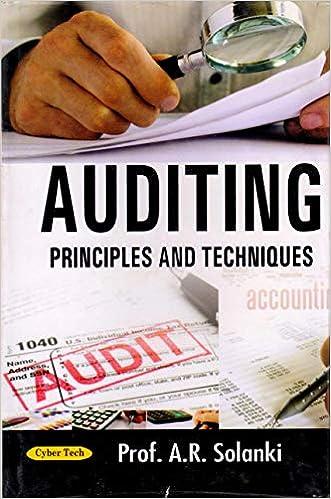Answered step by step
Verified Expert Solution
Question
1 Approved Answer
1. Problem: You have been assigned to work the test of details in the Accounts Receivable account. You have been given the Trial Balance, and

1. Problem: You have been assigned to work the test of details in the Accounts Receivable account. You have been given the Trial Balance, and the A/R balance is $300,000. Assume that you have looked into the previous years work papers and have determined the following:
- The Tolerable Error for this account is $10,000.
- The Expected Error for this account is $4,000.
- The Risk of Incorrect Acceptance is 10%.
Using the tables above, what is the Reliability Factor for Risk of Incorrect Acceptance? What is the Expansion Factor for Risk of Incorrect Acceptance? Hint: No calculations are needed.
FIGURE 9.14 Reliability Factors for Misstatements of Overstatement Number of Risk of Incorrect Acceptance Overstatement Misstatements 1% 5% 10% 15% 20% 25% 0* 4.61 3.00 2.31 1.90 1.61 1.39 1 6.64 4.75 3.89 3.38 3.00 2.70 2 8.41 6.30 5.33 4.72 4.28 3.93 3 10.05 7.76 6.69 6.02 5.52 5.11 4 11.61 9.16 8.00 7.27 6.73 6.28 5 13.11 10.52 9.28 8.50 7.91 7.43 6 14.57 11.85 10.54 9.71 9.08 8.56 7 16.00 13.15 11.78 10.90 10.24 9.69 8 17.41 14.44 13.00 12.08 11.38 10.81 9 18.79 15.71 14.21 13.25 12.52 11.92 10 20.15 16.97 15.41 14.42 13.66 13.02 30% 1.21 2.44 3.62 4.77 5.90 7.01 8.12 9.21 10.31 11.39 12.47 37% 1.00 2.14 3.25 4.34 5.43 6.49 7.56 8.63 9.68 10.74 11.79 50% 0.70 1.68 2.68 3.68 4.68 5.68 6.67 7.67 8.67 9.67 10.67 "The Orow is always wed for the reliability facke in the sample size formula and for basic precision. Source: AICPA, Audi Chelde: Audio Sopling (New York, 2001) FIGURE 9.15 Expansion Factors for Expected Misstatement Source: AICPA, Audi Cuilde: Sampling (New York, 2001). 1% 5% 1.6 Risk of Incorrect Acceptance 10% 15% 20% 25% 1.5 1.4 1.3 1.25 30% 1.2 37% 1.15 50% 1.0 Factor 1.9 FIGURE 9.14 Reliability Factors for Misstatements of Overstatement Number of Risk of Incorrect Acceptance Overstatement Misstatements 1% 5% 10% 15% 20% 25% 0* 4.61 3.00 2.31 1.90 1.61 1.39 1 6.64 4.75 3.89 3.38 3.00 2.70 2 8.41 6.30 5.33 4.72 4.28 3.93 3 10.05 7.76 6.69 6.02 5.52 5.11 4 11.61 9.16 8.00 7.27 6.73 6.28 5 13.11 10.52 9.28 8.50 7.91 7.43 6 14.57 11.85 10.54 9.71 9.08 8.56 7 16.00 13.15 11.78 10.90 10.24 9.69 8 17.41 14.44 13.00 12.08 11.38 10.81 9 18.79 15.71 14.21 13.25 12.52 11.92 10 20.15 16.97 15.41 14.42 13.66 13.02 30% 1.21 2.44 3.62 4.77 5.90 7.01 8.12 9.21 10.31 11.39 12.47 37% 1.00 2.14 3.25 4.34 5.43 6.49 7.56 8.63 9.68 10.74 11.79 50% 0.70 1.68 2.68 3.68 4.68 5.68 6.67 7.67 8.67 9.67 10.67 "The Orow is always wed for the reliability facke in the sample size formula and for basic precision. Source: AICPA, Audi Chelde: Audio Sopling (New York, 2001) FIGURE 9.15 Expansion Factors for Expected Misstatement Source: AICPA, Audi Cuilde: Sampling (New York, 2001). 1% 5% 1.6 Risk of Incorrect Acceptance 10% 15% 20% 25% 1.5 1.4 1.3 1.25 30% 1.2 37% 1.15 50% 1.0 Factor 1.9Step by Step Solution
There are 3 Steps involved in it
Step: 1

Get Instant Access to Expert-Tailored Solutions
See step-by-step solutions with expert insights and AI powered tools for academic success
Step: 2

Step: 3

Ace Your Homework with AI
Get the answers you need in no time with our AI-driven, step-by-step assistance
Get Started


